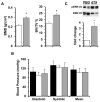Dimorphic effects of transforming growth factor-β signaling during aortic aneurysm progression in mice suggest a combinatorial therapy for Marfan syndrome
- PMID: 25614286
- PMCID: PMC4376614
- DOI: 10.1161/ATVBAHA.114.305150
Dimorphic effects of transforming growth factor-β signaling during aortic aneurysm progression in mice suggest a combinatorial therapy for Marfan syndrome
Abstract
Objective: Studies of mice with mild Marfan syndrome (MFS) have correlated the development of thoracic aortic aneurysm (TAA) with improper stimulation of noncanonical (Erk-mediated) TGFβ signaling by the angiotensin type I receptor (AT1r). This correlation was largely based on comparable TAA modifications by either systemic TGFβ neutralization or AT1r antagonism. However, subsequent investigations have called into question some key aspects of this mechanism of arterial disease in MFS. To resolve these controversial points, here we made a head-to-head comparison of the therapeutic benefits of TGFβ neutralization and AT1r antagonism in mice with progressively severe MFS (Fbn1(mgR/mgR) mice).
Approach and results: Aneurysm growth, media degeneration, aortic levels of phosphorylated Erk and Smad proteins and the average survival of Fbn1(mgR/mgR) mice were compared after a ≈3-month-long treatment with placebo and either the AT1r antagonist losartan or the TGFβ-neutralizing antibody 1D11. In contrast to the beneficial effect of losartan, TGFβ neutralization either exacerbated or mitigated TAA formation depending on whether treatment was initiated before (postnatal day 16; P16) or after (P45) aneurysm formation, respectively. Biochemical evidence-related aneurysm growth with Erk-mediated AT1r signaling, and medial degeneration with TGFβ hyperactivity that was in part AT1r dependent. Importantly, P16-initiated treatment with losartan combined with P45-initiated administration of 1D11 prevented death of Fbn1(mgR/mgR) mice from ruptured TAA.
Conclusions: By demonstrating that promiscuous AT1r and TGFβ drive partially overlapping processes of arterial disease in MFS mice, our study argues for a therapeutic strategy against TAA that targets both signaling pathways although sparing the early protective role of TGFβ.
Keywords: Marfan syndrome; aortic aneurysm; losartan; receptor, angiotensin, type 1; transforming growth factor β.
© 2015 American Heart Association, Inc.
Figures






References
-
- Milewicz DM, Guo DC, Tran-Fadulu V, Lafont AL, Papke CL, Inamoto S, Kwartler CS, Pannu H. Genetic basis of thoracic aneurysms and dissections: focus on smooth muscle cell contractile dysfunction. Annu Rev Genomics Hum Genet. 2008;9:283–302. - PubMed
-
- Dai J, Losy F, Guinault AM, Pages C, Anegon I, Desgranges P, Becquemin JP, Allaire E. Overexpression of transforming growth factor-β1 stabilizes already-formed aortic aneurysms: a first approach to induction of functional healing by endovascular gene therapy. Circulation. 2005;112:1008–1015. - PubMed
Publication types
MeSH terms
Substances
Grants and funding
LinkOut - more resources
Full Text Sources
Other Literature Sources
Medical
Molecular Biology Databases
Miscellaneous

